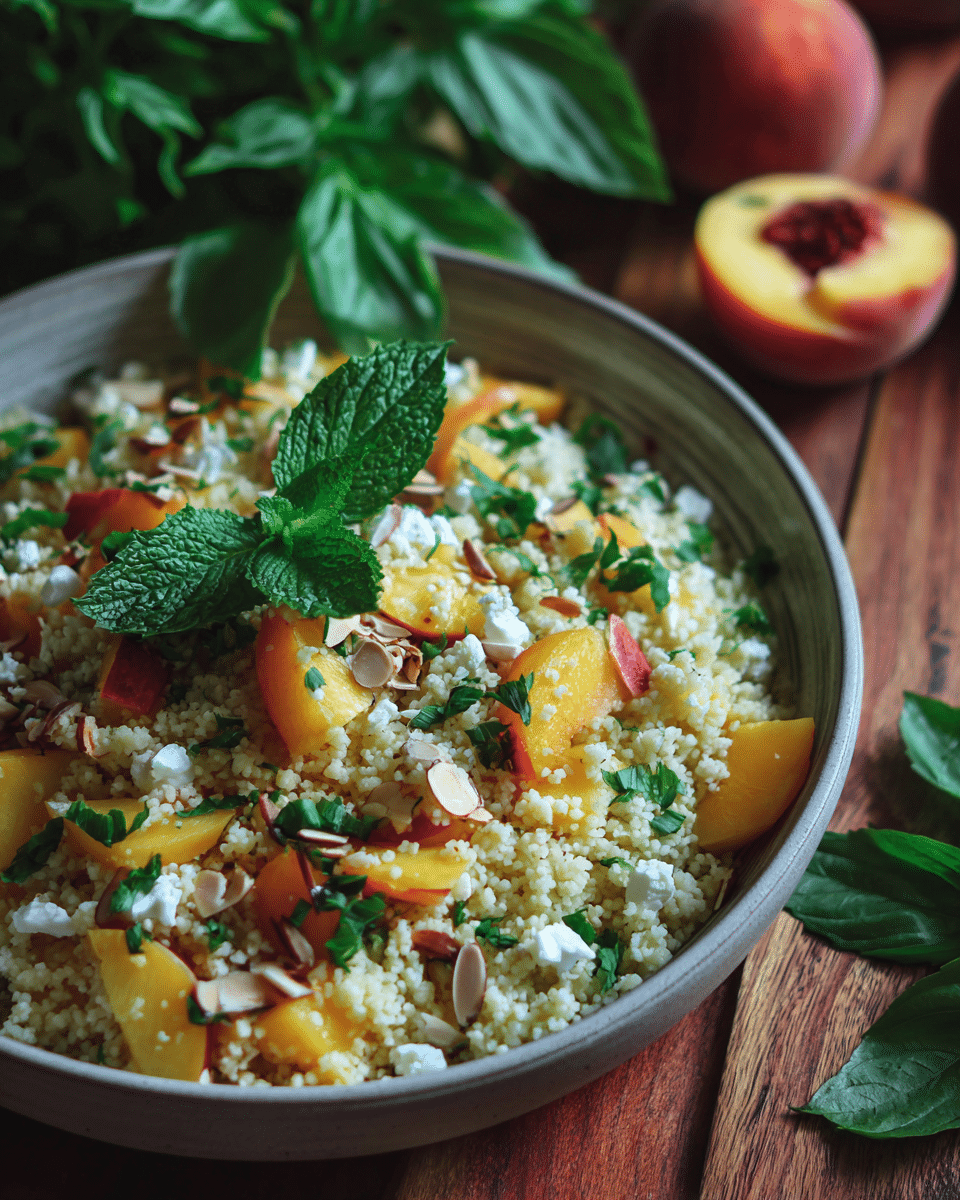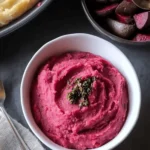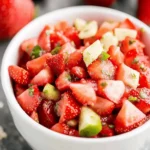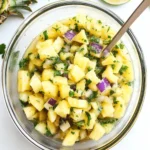A refreshing and vibrant dish, the Peaches and Herb Couscous Bowl is a perfect fusion of sweet, savory, and herby flavors. With the juicy burst of fresh peaches, the fluffiness of couscous, and the bright punch of herbs, this bowl is ideal for a light, wholesome lunch or a refreshing dinner option during warmer months. It’s quick to prepare, rich in fiber and vitamins, and completely vegetarian — though it can be customized with protein additions like grilled chicken or chickpeas.
FULL RECIPE
Ingredients
- 1 cup couscous
- 1 cup boiling water
- 1 tablespoon olive oil
- 1/2 teaspoon salt
- 2 ripe peaches, diced
- 1/4 cup fresh basil, chopped
- 1/4 cup fresh mint, chopped
- 2 tablespoons parsley, chopped
- 1/2 small red onion, finely chopped
- 1/4 cup crumbled feta cheese (optional)
- Juice of 1 lemon
- 1 tablespoon honey or maple syrup
- Salt and pepper to taste
- Optional: 1/4 cup toasted almonds or walnuts for crunch
Directions
- In a medium bowl, combine the couscous, olive oil, and salt.
- Pour boiling water over the couscous, stir once, cover, and let it sit for 5 minutes.
- Fluff the couscous with a fork to separate the grains.
- Add the diced peaches, chopped basil, mint, parsley, and red onion to the couscous.
- In a small bowl, whisk together the lemon juice, honey, and a pinch of salt and pepper.
- Pour the dressing over the couscous mixture and toss well to combine.
- Gently fold in the feta cheese (if using) and toasted nuts (if desired).
- Serve chilled or at room temperature as a light lunch, side salad, or vegetarian main.
Nutrition Facts
- Calories: 260
- Total Fat: 8g
- Saturated Fat: 2g
- Trans Fat: 0g
- Cholesterol: 5mg (if feta is added)
- Sodium: 190mg
- Total Carbohydrates: 40g
- Dietary Fiber: 4g
- Sugars: 11g
- Protein: 6g
- Vitamin A: 10% DV
- Vitamin C: 20% DV
- Calcium: 6% DV
- Iron: 10% DV
Origins of Couscous in Modern Recipes
Couscous has its roots in North African cuisine, traditionally made from semolina wheat and served with stews or vegetables. Over time, couscous has evolved into a versatile grain alternative used globally in salads, bowls, and even desserts. In modern recipes like the Peaches and Herb Couscous Bowl, couscous serves as a neutral base that absorbs flavors beautifully, marrying sweet and savory ingredients effortlessly. Its quick cooking time and light texture make it ideal for contemporary kitchen use, especially for those seeking health-conscious meal options.
The Nutritional Value of Couscous
Couscous is often favored for its low-fat, high-carb composition, making it a great energy source. It’s rich in selenium, a powerful antioxidant that helps support immunity and thyroid function. When paired with fruits like peaches and herbs, couscous becomes part of a well-rounded, fiber-rich dish. While not gluten-free, couscous can be substituted with quinoa for those with gluten sensitivities. Its nutritional value makes it suitable for vegetarians, athletes, and individuals aiming for balanced diets.
Health Benefits of Peaches
Peaches are a summer favorite that offer more than just sweetness. They are packed with vitamins A and C, potassium, and dietary fiber. These nutrients promote heart health, boost the immune system, and support healthy skin. When fresh peaches are combined with herbs and grains, they bring a refreshing juiciness and a wealth of nutrients to the dish. Their natural sugars are far healthier than processed sweeteners, making them ideal for health-conscious meals.
The Role of Fresh Herbs in Flavor and Wellness
Fresh herbs like basil, mint, and parsley not only add brightness and aroma to the couscous bowl but also offer significant health benefits. Basil is known for its anti-inflammatory properties, mint aids in digestion, and parsley provides a strong dose of vitamin K and antioxidants. Herbs are low in calories yet high in flavor, making them a perfect addition to meals focused on wellness and clean eating. Their inclusion in this dish enhances both taste and nutrition.
How This Recipe Supports a Balanced Diet
The Peaches and Herb Couscous Bowl offers a wonderful balance of macronutrients. Carbohydrates from couscous provide energy, peaches and herbs offer dietary fiber and vitamins, and optional add-ons like feta or nuts contribute protein and healthy fats. This makes the dish ideal as a light main course or hearty side. It supports weight management, stable blood sugar levels, and digestive health, especially when consumed as part of a diverse and colorful diet.
Perfect for Vegetarian and Flexitarian Diets
This recipe is entirely vegetarian and can easily be made vegan by omitting the feta cheese or replacing it with a plant-based alternative. For flexitarians, adding grilled chicken or fish can increase protein intake without compromising the fresh, vibrant profile of the dish. Its adaptable nature makes it suitable for households with varying dietary preferences and is ideal for Meatless Mondays or any plant-forward eating plan.
Meal Prep and Storage Convenience
The Peaches and Herb Couscous Bowl is excellent for meal prep. It can be made in large batches and stored in the refrigerator for 2 to 3 days without compromising flavor or texture. In fact, the flavors often meld more deeply overnight, making leftovers even more delicious. Since it can be served chilled or at room temperature, it’s a practical option for lunchboxes, potlucks, or picnics. The dish’s versatility and storability help reduce food waste and simplify weekly meal planning.
Seasonal and Local Ingredient Benefits
Using seasonal peaches not only ensures peak flavor and nutrition but also supports local agriculture and sustainability. Fresh, in-season produce has a higher vitamin content and a lower environmental impact due to reduced transportation needs. Herbs can even be grown at home, further reducing cost and carbon footprint. Incorporating locally sourced ingredients into dishes like this makes cooking more eco-friendly and community-oriented.
Culinary Versatility and Customization
One of the standout features of this dish is its adaptability. It can be transformed by switching the fruit (e.g., mango or berries), swapping the herbs, or adding proteins like tofu or chickpeas. Grain substitutions such as quinoa, barley, or bulgur also work well. This flexibility allows home cooks to experiment based on available ingredients, dietary restrictions, or personal preferences, making it an excellent base for creative, nutritious meals.
Visual and Textural Appeal
Visually, the Peaches and Herb Couscous Bowl is a showstopper. The golden couscous, vibrant green herbs, and warm hues of peaches create a colorful presentation that invites you to eat with your eyes first. Texturally, the dish offers a delightful contrast: soft couscous, juicy fruit, crisp onion, and optional crunch from nuts. This interplay of colors and textures enhances the eating experience and can encourage healthier food choices, especially for those new to whole-food meals.
Advertisement
A Light Yet Satisfying Summer Dish
This recipe is particularly well-suited for summer due to its cooling ingredients and minimal cooking requirement. It’s refreshing and hydrating, thanks to the juicy peaches and fresh herbs, making it perfect for hot-weather dining. Unlike heavy meals, this bowl is light yet filling, ideal for lunches, outdoor gatherings, or light dinners. When served chilled, it becomes an excellent alternative to traditional cold pasta or potato salads.
Conclusion
The Peaches and Herb Couscous Bowl brings together health, flavor, convenience, and beauty in one dish. Its thoughtful combination of fruits, herbs, grains, and optional extras makes it suitable for various dietary needs and occasions. Whether you’re looking for a vibrant lunch, a unique salad, or a plant-forward main course, this recipe delivers in both nutrition and taste. Its ease of preparation and high adaptability make it a valuable addition to any modern kitchen repertoire.






